~宇宙・循環・つながるいのち~
開催のおしらせ
大阪・関西万博 日本館 のキーワード「循環」「いのちのつながり」について、主に中~大学生向けに、
火星の石をはじめとする宇宙に関連した展示を切り口として、豪華ゲストが語り尽くします。

- 【開催日時】
- 2025年8月24日(日)
14:00~15:30(13:30開場)
- 【開催場所】
- EXPOサロン
(リングサイドマーケットプレイス西2階)
- 【主主催催】
- 日本館
- 【協協力力】
- 三菱未来館



研究分野は、惑星科学・アストロバイオロジー。火星や木星・土星の衛星といった太陽系天体での生命生存可能性、火星や木星・土星の衛星といった太陽系天体での生命生存可能性、地球の生命の起源について研究を行う。






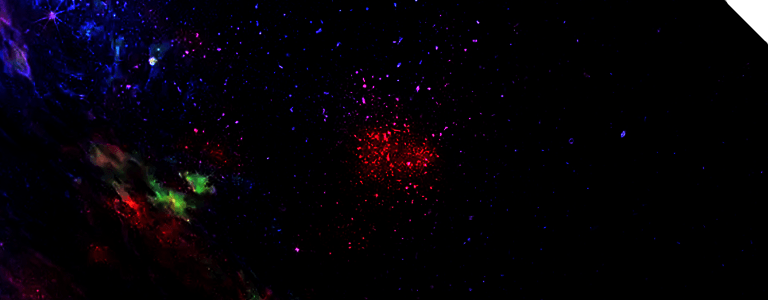










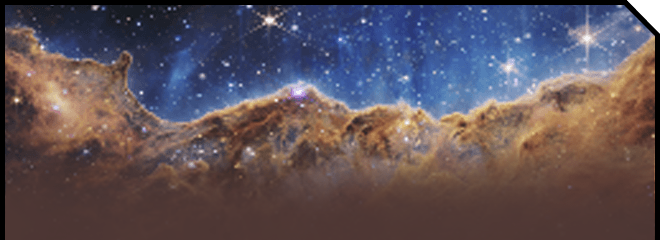






僕らの棲む地球とはどんな星なのでしょうか? その特徴は、宇宙からその姿を見るとよくわかります。青い海に白い雲がたなびく水惑星である地球。太陽のような恒星が誕生する際、周辺に残る塵が集まり地球のような小さな惑星たちができます。惑星が恒星の近くにできれば灼熱の惑星になり、また遠くにできれば極寒の惑星になります。地球が液体の海を持つことができたのは、熱すぎず、寒すぎない、太陽からほどよい距離に、偶然、地球が誕生したためです。恒星の周りのほどよい距離に、地球のような水惑星が誕生する確率は約1%ほどだといわれています。地球は、100回に1度のくじが当たるような確率でしか誕生しないということです。

しかし一方で、太陽があるこの天の川銀河には2000億もの恒星があります。
単純に考えて2000億の1%、つまり20億個ほどの水惑星が、天の川銀河に存在していることになります。さらに、天の川銀河は、この宇宙に無数にある銀河の1つでしかありません。宇宙には、無数の“地球たち”が存在しているのです。これら“地球たち”は、いのち(生命)あふれる惑星なのでしょうか。今回は、この地球という惑星に、いかにして生命が宿り、そして生命あふれる今の姿になったのかという話をしたいと思います。そういった生命と地球の進化を見つめることで、地球生命は宇宙で孤独な存在なのか、それともありふれた存在なのかを考えてみたいと思います。


40億年に渡る生命と地球の進化は、決して緩やかな坂道を上るようなものではありませんでした。その進化は、ドラマチックな大変動と、それによって区切られるいくつかの段階(エポック)がありました。皆さんと一緒に、地球生命にとって運命的といっていいこれらのエポックを振り返ってみることにします。同時に、地球生命進化の視点から今という現在を見つめ直し、今から始まる未来も考えてみたいとも思っています。


現在、地球上には、数千万種ともいわれる多様な生命が育まれています。象のように巨大な陸上の哺乳類から、深海の魚類や甲殻類、空を飛ぶ昆虫、目に見えないバクテリアのような微生物まで、生命が棲む環境やその大きさは様々です。そのような生命の多様性は、40億年という途方もない時間に渡る生命進化の結果です。同時にそれは、生命が勝手気ままに進化した結果ではなく、地球の環境自体が大きく進化したことに合わせて、生命も新しい環境に挑戦し、柔軟に、たくましくその姿を変え続けてきた結果だともいえます。順応できなかった生命は、絶滅という形で姿を消していきました。絶滅した生命種は現在の種より、はるかに多かったことでしょう。地球生命ものがたりにおける第1のエポックは「いのちの始まり」、つまり生命の起源です。大河の源流が、山から沁みだす1滴の水のしずくにあるように、これら多様な生命たちも、元を正せば、1つの始まりに源流をもつ同じ生命です。
地球生命は、今から約42億年前から40億年前に誕生したと考えられています。
「考えられています」と書いたように、生命が地球上に誕生した、そのときの決定的な証拠はありません。
地上に残る最古の地層は40億年前のもので、それより昔の証拠はありません。この40億年前には生命が存在していたので、生命の誕生はそれより前ということになります。一方で、地球そのものは45億年前に誕生しました。原始の地球は最初、高温のマグマの海で覆われていました。その後、マグマが冷えていく過程で大気ができ、海ができていきましたが、最初の数億年間は、海が全て蒸発するような巨大隕石の衝突も頻発していました。生命が誕生できるような環境が整ったのは42億年くらい前のことです。地球生命がどこでどのように誕生したのか、証拠がないため本当のことはわかりません。ですが、多くの科学者が共通して重要だと思っている場があります。それは海底にある温泉、すなわち熱水噴出孔です。


生命が生きていくために必要な3つの要素があります。それは、「有機物」、「水」、「エネルギー」です。生命をアナログ時計に例えれば、「有機物」は時計を作る歯車やねじなどの部品であり、「水」はそれらを滑らかにつなぐ潤滑油であり、「エネルギー」は電池に例えられます。これら3つがあって初めて、時計は時計の働きが可能になり、生命は生命活動をすることができます。生命活動とは、細胞分裂や代謝といった生命固有の活動です。
熱水噴出孔が生命の起源に重要と考えられる点の1つは、この3要素がごく自然に手に入るということです。中でも大事なのはエネルギーです。時計は電池が切れれば動かなくなるように、生命もエネルギーなしではすぐに死んでしまいます。



熱水噴出孔では、熱水が岩石と触れ合い、化学反応することで水素などの分子が生まれます。そういった熱水と岩石の反応の生成物は、原始的な生命の食料となります。現在の地球で生きる原始的な生命たちはことごとく、この熱水と岩石の反応でできる水素を食料としてエネルギーを得ています。いわば、岩石に根差し、地球から熱のエネルギーを少しだけわけてもらい、生命というアナログ時計を動かす生き方だといえます。
生命誕生前夜、熱水噴出孔では岩石と熱水の反応で、様々な分子が生まれていました。そういった中から、やがて生命の機能に近い働きを持つ複雑な有機物が生まれ、原始生命に至ったと考えられています。これが“いのちの始まり”です。


熱水噴出孔で生まれた原始生命たちは、最初は細々と自信なさげに慎ましやかに生きていましたが、やがて環境にも慣れ、増殖を始めます。熱水噴出孔で手に入る水素や地球の熱エネルギーが不足するまで増殖を重ねていきます。盛んに増殖を始める個体が出ると、それは多くの子孫を残します。結果的に、そのようなアグレッシブな個体が優先的に生き残ることになります。そこには、かつての慎ましやかな姿はもうありません。
やがて微生物の数は、熱水噴出孔が生命を育むことのできる限界量―キャパシティに達し、追い出されるようにして、熱水噴出孔を飛び出した微生物がいます。あるいは、単に海流の流れに飲み込まれただけかもしれません。
これら微生物たちは、海の中をたゆたいます。自力で泳ぐことはできないので、運任せに漂うしかないのです。ごく少数の運のよい微生物は別の熱水噴出孔にたどり着けますが、ほとんどの微生物は食料のない砂漠のような海で死滅します。
面白いのは、そのような漂う微生物に奇跡的な能力を発現させたものが出たことです。その能力とは、光合成です。微生物がもともと持っていた光を感知する有機物が変化して、太陽光をエネルギーにして周囲の水を分解し、水素を取り出すことに成功したのです。水素は熱水環境で生み出される食糧、つまりエネルギー源です。これを熱水なしで、太陽光から自力で作る能力を生命は初めて得たのです。
光合成とは、進化における奇跡かもしれません。漂う微生物の遺伝子に変異が起こり、光合成を可能にする分子を生み出すことが、どのくらいの確率で起きうるのでしょうか。

約30億年前に誕生したといわれる光合成は、地球生命による最も重要な技術革新の1つです。それまでは、「地球の熱」をエネルギーとして生きていた生命が、「太陽の光」をエネルギーとして利用できるようになったのです。これにより、狭くローカルな、暗い海底の熱水噴出孔にひしめくように生きていた生命が、一気に太陽光の当たる地球全域に進出可能になりました。これが“いのちの広がり”です。
しかし、光合成生物が誕生したからといって、全地球がすぐにその生命で満ち溢れるわけではありません。もう1つの大事件が、地球に起きる必要がありました。それは、約25億年前におきた、地表全てが氷で覆われる「全球凍結」と呼ばれる大氷河時代でした。
全球凍結後が鍵であったのは、氷河時代直後の地球がその反動で一転して猛烈な温室状態になったことによります。超温室状態で光合成生物は大繁殖を起こします。かつて、原始的な微生物が熱水噴出孔で得られるエネルギーの限界まで増殖したように、今度は光合成生物が、超温室状態で限界まで増殖します。これにより、光合成生物が全地球に広がり、光合成の産物として酸素が一気に大気に満ちたのです。






この約25億年前から22億年前に起きた「大酸化事変」は、地球史最大の環境汚染といえるものでもありました。酸素は、それ以前に生きていた微生物にとっては猛毒です。多くの微生物は死に絶え、生き延びたものも酸素の届かない深海の泥の中に生息域を変えていきました。また、酸素大気の登場により、海の化学組成も一変しました。酸素は海に溶けていた鉄分を真っ赤な鉄さびとして海に沈殿させ、代わりに酸素があることで供給されやすくなる硫黄が海の主要成分の1つになりました。当然、このような海洋成分の大変化は、当時の生態系を一変させるものでした。
一方で、この酸素に適応し、したたかにもこれを使って呼吸する生命が現れました。僕ら真核生物の祖先です。酸素を使った呼吸は莫大なエネルギーを生みます。例えるなら、熱水噴出孔で得られるエネルギーがアナログ時計のコイン電池程度だとすれば、酸素呼吸は自動車も動かすバッテリーほどのエネルギーを生み出します。電池が大きくなれば動かせる機械が大きくなるように、酸素呼吸を獲得した生命は、そのエネルギーを利用して大きく複雑になっていきます。
地球はその後、約6億年前にも「全球凍結」を経験し、その直後に、同様の光合成生物の大増殖と、2度目の大気中の酸素濃度の上昇が起きました。2度目の酸素濃度上昇は多細胞生物たちを生み出しました。多細胞生物は、高い酸素濃度がもたらす高いエネルギーが可能にする運動能力で、海から陸へと生息域を拡大していきました。そして、ついに“いのちの広がり”は、陸地を含む全地球に及んだのです。


生命に必要な3要素、「有機物」、「水」、「エネルギー」。光合成というエネルギー獲得方法の変革が、地球規模の環境汚染を引き起こし、それに適応した生命が一気に生息域を拡大しました。
同様のことが、今現在、人類による産業革命と機械文明によって起きていますともいえます。熱水噴出孔の地球の熱のエネルギーで生きる時代を第1のエポック、太陽光のエネルギーで生きる時代を第2のエポックとすれば、現在は地球生命40億年の視点から見ても、第3のエポックに突入しているといえます。
人類が化石燃料を利用し、あるいは原子力を利用してエネルギーを得ることは、言い換えれば、これまでの生命がその瞬間に得られるエネルギーを活用していたのに対して、時間を超越して、過去や未来のエネルギーを自在に獲得していることに他なりません。化石燃料とは、過去の太陽エネルギーが保存されているもので、原子力は未来に起きうる核分裂を人工的に早めてエネルギーを取り出す技術だともいえます。


時間を超えたエネルギーを獲得することで、人類は自動車や電車を動かし、巨大な都市、ビル群を作り、ロケットを宇宙空間にまで飛ばしています。これまでの生命が、自分の体を大きく複雑なものにし、高い運動能力を獲得していったのと基本的には同様です。
人類の文明は、地球生命がかつて光合成能力を獲得したことに匹敵する、地球生命が起こした最も重要な技術革新です。現在の地球温暖化や環境変動は、大酸化事変後の環境汚染と対比されるでしょう。
エネルギーの獲得段階が進むにつれ、生命がその生息域を飛躍的に拡大させてきたことを思えば、人類が文明を興し、その結果、現在生活圏を火星にまで広げようとしているということは、生命進化の必然といっていいかもしれません。
僕は、この第3のエポックである人類の文明に対して、否定的でも悲観的でもありません。ただ、地球生命の歴史に照らしてみれば、現在という時代も見方が変わるということをお伝えしたかったのです。
第3のエポックである“いのちの未来”は始まったばかりです。皆さんは、この時代の輝かしい担い手です。人類が、熱水噴出孔に生きる微生物や光合成生物と本質的に違うのは、多細胞生物になり、社会を作って生きる中で、助け合う、思いやる、ということが、生きる上で根本的な要素になっているということです。きっとこれまでのエポックを作った生命とは違った形で、人類は生きていくことができるのではないかと、僕は思っています。
宇宙には、無数の水惑星—“地球たち”があります。その内のいくつかには、文明を持った惑星も存在しているかもしれません。そういった宇宙を知ることで、僕らの生き方もなにか変わってくるのかもしれません。




What kind of planet is our Earth? Its characteristics are easily visible when seen from the outer space. With blue oceans and trailing clouds, Earth is a planet covered with water. When a star like the Sun is born, remaining nearby dust can clump together and form small planets like Earth. When one is formed closer to such a star, it becomes a hot, burning planet of fire. When one is formed far from the star, it becomes a cold, frozen planet. Earth has liquid oceans simply because it was coincidentally formed at exactly the right proper distance from the Sun, where it is not too hot or too cold.
The chances of an ocean planet, like Earth, being formed a proper distance from a star is believed to be about 1%. Earth was born under a probability of only one in one hundred.

Meanwhile, there are 200 billion stars in the Milky Way, the galaxy that includes our Solar System. A simple estimation suggests that there may be 1% of 200 billion, or two billion, ocean planets in the Milky Way. Moreover, the Milky Way is just one of the innumerable galaxies in the universe. Probability suggests there are many more Earth-like planets in the universe.
But are these other Earths full of life like ours?
Today, I’d like to talk about how life was born on our planet Earth, and how it achieved its current form, teeming with life. By watching the evolution of both Earth and life itself, let’s consider whether we really are alone in the universe, or if life like ours could be incredibly common.


The four-billion-year evolution of both life and Earth was no gentle stroll up an even slope. Instead, it involved dramatic convulsions and several epochs of ups and downs. I am going to take us through these epochs, each one key to the destiny of the Earth. We’re also going to evaluate the present from the perspective of evolution of life on Earth, and then think about the future, which starts from this moment.


Today, Earth is home to several tens of millions of species of life. It includes huge terrestrial mammals like elephants, fish and crustaceans deep in the sea, flying insects, and practically invisible microorganisms like bacteria. Life is diverse not only in size but also in habitat.
This diversity is a result of the evolution of life, which has spanned the extraordinarily long period of four billion years. At the same time, it is not the result of the self-willed evolution of organisms. Instead, it is a consequence of the dramatically evolving Earth, each challenging new environment thus created, and life having to continue to change flexibly and vigorously to keep up. Those that could not adapt disappeared—what we call becoming “extinct.” Far more species have gone extinct in the history of the Earth than currently live on our plant today.
The first epoch in the story of life on Earth is the beginning of life, or the origin of life. Much like how a big river starts from a drop of water seeping out from a mountain, all our diverse lifeforms started from one single common origin.


Life on Earth is believed to have been born about 4.2 to 4 billion years ago. I say “is believed” as there is no absolute evidence that proves when life began on Earth. The oldest marine sedimentary rocks remaining on our planet are 4 billion years old, meaning there is no older data. Because life existed already four billion years ago, life must have been born at least that long ago.
Meanwhile, Earth was formed 4.5 million years ago. Early Earth was first covered by high-temperature magma oceans. Later, when the magma started to cool down, the atmosphere and oceans were formed. During the first several hundred million years, however, Earth was subjected to frequent massive asteroid impacts, which likely caused all the oceans to evaporate. It was only about 4.2 billion years ago when an environment ready for the beginning of life was finally shaped.
Exactly where and how the life on Earth was born is a question for which no one knows the true answer, as there’s no conclusive evidence. Despite this lack, many scientists agree on a location that is likely the key—these being underwater hot springs, scientifically called “hydrothermal vents.”


Three elements are essential for life to survive; organic matter, water, and energy. Comparing life to an analog clock, organic matter are the parts constituting the clock, such as gears and screws; water is the lubricating oil that smoothly connects the components; and energy is the battery. A clock can function only when these three are assembled, and the same applies to life. Life can perform biological activities—those activities particular to life, such as cell division and metabolism—when the three elements are available.
One of the reasons why hydrothermal vents are a key in studying the origin of life is that these three vital elements are naturally available there. Of them, energy, is the most important. Like a clock, which stops functioning when the battery goes dead, life dies quickly when there is no energy available.

In and around hydrothermal vents, hot water touching rocks causes chemical reactions that involve the formation of molecules such as hydrogen. The products of such reactions between hot water and rocks serve as food for primitive lifeforms. All primitive organisms that currently live on Earth feed on hydrogen, produced through reactions between hot water and rocks, and gain energy. They settle on rocks and receive a tiny proportion of heat energy from Earth to power the analog clock of life.
At the eve of abiogenesis, when life emerged from non-living matter, diverse kinds of molecules were formed in and near hydrothermal vents through reactions between rocks and hot water. From such molecules. complicated organic substances that had functions much like life emerged and are believed to have evolved into primitive life. This was the “beginning of life”.


Primitive lifeforms born in hydrothermal vents first lived a weak and meagre existence. Soon they became accustomed to the environment and started to propagate. The propagation continued until the hydrogen and geothermal energy available at the thermal vents became insufficient to support them. Individual organisms that actively propagated left many offspring. As a result, such aggressive individuals could preferentially survive. The survivors were not weak and meagre anymore.
Before long, the number of microorganisms reached the limit of the life-nurturing capacity of the origin hydrothermal vent. Some left the vent, being displaced or simply being engulfed by oceanic currents. These microorganisms drifted about in the sea. They could not swim and so were adrift, leaving their life to fate. A few lucky ones reached another hydrothermal vent. Most of the microorganisms perished in the foodless desert of the sea.
Interestingly, there emerged some that expressed a miraculous ability that we call photosynthesis. An organism’s substances for detecting light underwent changes and became able to use solar energy to break down the surrounding water and produce hydrogen. Hydrogen is the food produced in a hydrothermal environment—in other words, an energy source. For the first time, life acquired the capability to create energy without hot water, from sunlight.
Photosynthesis is one miracle in the evolution of life. The chances must be minute that a mutation occurs in the gene of a drifting microorganism so that molecules enabling photosynthesis are created!

Photosynthesis is believed to have emerged about three billion years ago and is one of the most important biological innovations by life on Earth. Until then, life relied on the heat of the Earth for its energy. With photosynthesis, it became possible to use sunlight as energy instead. This innovation freed organisms from life crowded around small and local hydrothermal vents deep undersea, and allowed them to simultaneously spread to all parts of the world exposed to sunlight. This is known as the spread of life.
However, the emergence of photosynthetic organisms alone did not immediately lead to the entire Earth becoming full of the life. Another major event also had to occur. This was the global glaciation that occurred about 2.5 billion years ago, called a snowball Earth event, and during which the entire global surface was covered by ice.
The snowball Earth glaciation was a key event because of the intense greenhouse effects that occurred as a reaction immediately after the glaciation period. In this resulting ultra-greenhouse climate, the population of photosynthetic organisms exploded. As prior primitive organisms once propagated to the upper energy limit of their hydrothermal vent homes, photosynthetic organisms propagated to the upper limit offered during the greenhouse Earth. Photosynthetic organisms spread throughout the globe and rapidly filled the atmosphere with oxygen, a byproduct of photosynthesis.






This Great Oxidation Event occurred about 2.5 billion to 2.2 billion years ago and still marks the worst environmental pollution in the history of the planet. Oxygen was highly toxic to microorganisms. Most of them died out, and those survived shifted their habitat to the silt of the deep-ocean seabed, where oxygen could not reach. Atmospheric oxidation—the increase in oxygen content of the atmosphere—also caused changes in the chemical composition of oceans. Oxygen caused reduced iron dissolved in the oceans to precipitate on the seabed as oxidized red iron deposits. Sulfur became a major component in the oceans because the presence of oxygen increased its supply. Such drastic changes in marine water composition caused far-reaching changes to the ecosystem of the time.
Meanwhile, life also emerged that adapted to the oxygen-rich environment and efficiently used the gas for respiration. These are the ancestors of humanity, eucaryotes. Respiration using oxygen produces enormous amounts of energy. Comparing life with our analog clock once again, if the energy acquired at a hydrothermal vent is deemed a button battery, then aerobic respiration—using oxygen—produces energy enough energy to move an automobile. Just like a larger battery being able to move a larger machine, life that acquired aerobic respiration became larger and more complex by using that same energy.
Earth experienced global glaciations and became the snowball Earth again about 600 million years ago. Immediately after the glaciation periods, a similar massive propagation of photosynthetic organisms and second oxidation of the atmosphere occurred. The second oxidation event caused multicellular life to emerge. Multicellular organisms expanded their habitat from the sea to the land, backed by their motor capabilities powered by high energy from the higher oxygen concentration. Finally, the spread of life came to cover the entire globe, including the land.


The three essential elements for life: organic matter, water, and energy. A revolution in gaining energy, called photosynthesis, in turn causing environmental pollution of global scale. And life that adopted to the change being able to rapidly expand their habitat.
Similar phenomena can be said to be happening due to the human industrial revolution and mechanized civilization. From the perspective of the four-billion-year history of life on Earth, if we call the period when life relied on the heat energy from Earth the first epoch, and the period of using sunlight energy the second epoch, we currently find ourselves in the third epoch.
Humanity uses fossil fuels and atomic power to gain energy. This means that, which previous organisms used energy that was available only in the moment, humanity can freely obtain energy from the past and future, surpassing the flow of time. Fossil fuels are preserved solar energy from the past. Atomic power involves gaining energy by artificially accelerating nuclear fission that may occur in future.
Acquisition of energy that surpasses time has enabled humankind to power automobiles and trains, construct huge cities and tall buildings, and launch space ships into outer space. It is basically the same as previous organisms increasing the size and complexity of their bodies and earning higher motor capabilities.
Human civilization is one of the most important innovations made by life on earth, closely equivalent to the acquisition of photosynthetic ability by those simple lifeforms in the distant past. Current global warming and environmental changes may be comparable to the environmental pollution caused by the Great Oxidation Events.


As the stages of energy acquisition have advanced, life has expanded its habitat dramatically. From that perspective, it may be an inevitable consequence of the evolution of life that we have developed our current civilization and are spreading our living sphere to the Moon and eventually to Mars.
I am neither negative nor pessimistic about human civilization, which marks the third epoch. My point is that the period called the “present” may give a different impression when it is seen from the history of life on Earth.
The future of life and the third epoch has just started, and we are all are a wonderful, integral part of this period. Humanity is fundamentally different from hydrothermal vent-dwelling microorganisms and photosynthetic organisms, in terms that helping each other and sympathy for each other have become basic building blocks for us to live as social multicellular organisms. I believe that humankind will be able to survive in a manner different from those of lifeforms that marked the past two epochs.
There must be a vast number of ocean planets, like Earth, out in the universe. There may even be some on which civilization has evolved. An awareness of these universal possibilities may come to alter our way of living in interesting ways.




地球以外に生命を育む星は宇宙にあるのでしょうか — 今回は、現在の太陽系での生命探査の最前線についてお話ししたいと思います。
しかし、どのようにして生命を宇宙で探したらよいのでしょうか。ひとつ前のコラム(『地球生命40億年ものがたり』)でもお話ししたように、地球上の生命が生きていく上での必須要素は3つあると言われています。それは、「有機物」、「水」、「エネルギー」です。地球上でも、この3要素が存在する場所には、必ず生命が存在します。



宇宙において生命を探すためには、まずはこれらが存在する天体を見つけよう。1970年代に始まった太陽系探査は、この3要素を宇宙に探し、生命を育む惑星を探すということが大目的の1つでした。まずは、液体の水を探す、その後は有機物やエネルギーを探す。2000年代には“Follow the water(水を探せ)”が、そして今では“Follow the carbon(炭素(有機物やエネルギーのもとになる)を探せ)”がNASAの太陽系探査のキーワードになりました。


50年にわたる探査の結果、液体の水、あるいはそれが存在していた痕跡は、この太陽系で地球以外にも多くの天体で見つかっています。さらには、いくつかの天体では有機物やエネルギーも見つかっており、生命そのものの発見も、あるいは近いかもしれないともいわれています。
そういった天体の候補は、火星、そして木星の衛星エウロパ、土星の衛星エンセラダスです。火星は、三菱未来館『JOURNEY TO LIFE』の旅の目的地でもありました。火星は、地球のお隣の少し小さな惑星です。地球と比べて太陽からの距離が少し遠いため、地表の平均気温もマイナス50℃と寒冷です。しかし、夏の間にはプラス15℃くらいになることもあります。大気はありますが、地球に比べるとおよそ百分の一と薄い大気しかありません。今は、寒冷で赤茶けた砂漠が広がる惑星です。まずはその火星から、今我々は生命にどこまで迫れているのか、お話ししましょう。

火星には、これまで最も多く探査機が送り込まれています。周回機は、火星の周りを回りながら地表の写真を撮り、地表にどんな物質が存在しているかを調べています。2006年に火星に到着した周回機マーズ・リコネッサンス・オービターは、空間解像度30センチメートルという驚くべき詳細さで地表面を観察しています。
高空間解像度で地表を見ると、色々なものが見えてきます。河川や湖といった水が作る地形の跡があります。これは、太古の火星が水の惑星だった確たる証拠です。それだけでなく、その川底や湖底に粘土鉱物や塩といった水があることでできる物質もみつかります。これらも火星に水がふんだんに存在した証拠です。
粘土鉱物や塩は、水の存在だけでなく、できた当時の温度や水量など環境の情報も保存しています。このような水が作る地形や粘土・塩を示す証拠が、火星上で数千カ所も見つかっており、それらがおよそいつできたのかという時代も決まっています。粘土鉱物や塩の証拠から当時の環境を復元し、それを時代ごとに並べ直します。すると、おぼろげながら、火星の環境史の年表が出来上がります。その大まかな年表とは次のようなものです。
約40億年前の火星は、地表に液体の水が豊富に存在していました。河川や湖、海もあり、温暖な環境でした。今よりずっと厚い大気もあり、火星が最も地球に似ていた時期でした。しかし、約35億年前ごろになると、火星では乾燥寒冷化が進みました。水が存在する地域はまばらになり、そこの水質も強酸性、つまり酸の湖となっていました。さらに30億年前以降では、もはや液体の水の痕跡はなくなり、火星は現在のような砂漠の惑星になっていきました。
 NASA/JPL
NASA/JPL NASA
NASAこのような環境の変化は、なぜ起きたのでしょうか。それは、火星が地球よりも小さく、その大気が重力を振り切って宇宙に逃げていき、一方で大気を補充する火山活動も低下したためだと考えられています。逆にいえば、地球は今の大きさがあったため、活発な火山活動を維持して、水惑星の姿を現在まで保てているともいえます。しかし、その火山活動のために、地球では生命が始まった40億年前以前の記録は完全に失われています。逆に、火星では途中で火山活動が止んだため、その当時の記録がふんだんに残されているのです。地球では失われた生命誕生の痕跡が見つかるかもしれない — それが火星生命探査の面白さです。

火星についていえば、水、エネルギー、有機物という3要素のうち、水については、約35億年前までは火星上に確かに存在していました。また、エネルギーとなる太陽光も地表に降り注いでいました。となれば、最後は有機物です。生命のもとになる有機物は、当時の火星にあったのでしょうか。
このような疑問に答えるためには、火星周回機による情報だけでは不十分です。有機物は地層中では微量であり、着陸した探査車による詳細な分析が必要となるからです。
すでに火星には、1トン近くもある大きな着陸探査車が降り立っています。探査車は顕微鏡で地層を観察し、試料を採取し、それを様々な分析装置で調べます。その姿は、さしずめ火星に降り立ったロボット科学者のようです。
 NASA/JPL-Caltech/MSSS
NASA/JPL-Caltech/MSSS NASA/JPL/USGS
NASA/JPL/USGS探査車キュリオシティは、かつて37億年前にその内部に湖を有していたゲイル・クレーターと呼ばれる衝突クレーターの内部に着陸しました。そして、太古の湖に堆積した泥や砂に降り立ち、かつての湖底の泥を採取して分析を始めました。
キュリオシティが、ゲイル・クレーターの泥や砂の堆積物を分析すると、どの泥にも有機物が含まれていました。湖があった当時、有機物は湖水と共に存在し、泥と一緒にタイムカプセルに保存されていたのです。地球上でも湖の堆積物には、湖で生きていた微生物が有機物として保存されています。つまり、「水」、「エネルギー」に加えて、「有機物」も広く当時の火星に存在していることがわかりました。2019年のことです。
さらに驚きだったのは、その有機物の成分でした。有機物には、大量の硫黄が含まれていたのです。地球上の有機物には、これほど硫黄に富んだものはほとんどありません。というのも、地球の泥に含まれる有機物はほぼ生物由来で、炭素や窒素、酸素、リンといった元素を含みます。火星の有機物は、窒素やリンがほとんどなく、その代わりに硫黄を多く含んでいたのです。
 NASA
NASA NASA
NASAこの有機物が火星生命の痕跡なのか、生命誕生前夜の有機物の痕跡なのか、その正体は不明のままです。しかし、少なくとも、太古の火星において生命が誕生するのであれば、地球生命とは元素レベルで違う生命だといえるのかもしれません。元素レベルで地球生命と違う生命が見つかれば、地球生命は数多ある「生命」の1つだということを認識し、「生命」とは何かということをもっと広い視野で理解することができます。
火星には多くの探査車が到着しており、無人機によるサンプルリターン計画もあります。さらに、有人火星探査計画もあります。『JOURNEY TO LIFE』で描かれていたように、火星にかつて存在した海や湖の一部は、現在でも地下に凍土として存在しているともいわれています。これら試料を地球上や火星上で詳しく調べれば、太古の泥や砂の堆積物、あるいは凍土で冷凍保存された有機物が、果たして生命の痕跡なのかもわかるのではないかと期待されています。
 NASA
NASA NASA
NASAさて、次は火星を超えて、木星以遠の外側太陽系に行ってみましょう。そこでは、太陽光は弱く、氷が主役の極寒の世界が広がります。木星や土星には、氷の月たち(氷衛星)が周っています。見た目は、宇宙に浮かぶ雪玉のようです。地表面温度はマイナス150℃を下回り、水だけでなく二酸化炭素なども凍っています。
そのような極寒の外側太陽系では、生命はおろか海の存在も期待できないと、みなさんは思われるかもしれません。しかし、これら氷衛星のいくつかの地下には、液体の水が「地下海」として現存することが明らかになっています。

地球外天体で初めて、今でも液体の海が存在することが明らかになった天体が、木星の衛星エウロパです。エウロパの表面には、衝突クレーターがほとんどありません。これは氷の下からの地下海が噴出したり、地下海のために氷が流動化したりすることで、形成したクレーターが消されているためです。
また、エウロパをよく見ると、その表面には縦横無尽に走る赤い筋があることに気が付きます。この赤い筋もエウロパに地下海がある証拠の1つです。赤い筋の正体は氷表面の割れ目を埋める塩分です。氷の割れ目に塩分を含む地下海が顔を出し、宇宙空間にさらされた瞬間に冷凍されます。しかし、海水に含まれる塩分は宇宙空間で赤く変色し、赤い筋となるのです。
エウロパは木星をわずかに楕円軌道で周っています。そのため、木星から近いときには木星の重力でエウロパ自体の形状がゆがみ、木星から遠いときには元に戻るといったように変形します。この変形で内部の岩石に摩擦熱が生まれて、それが氷を溶かして極寒な世界に豊かな地下海をつくってるのです。

エンセラダスは土星の氷衛星の一つで、直径500キロメートル程度のとても小さな天体です。この小さな衛星でもエウロパ同様に地下海が存在します。さらに、それだけでなく、南極付近の地表の割れ目から海水が間欠泉のように宇宙に噴出しています。
2017年にミッション終了したNASAの探査機カッシーニは、それまでの間、エンセラダスの間欠泉の中を何度か通過し、史上初めての地球外海水のサンプリングを行いました。その結果、噴出している海水には、塩分や二酸化炭素やアンモニアなどのガス、有機物が含まれることが明らかになりました。有機物はメタンなどの単純な分子から、微生物サイズの大きさの複雑なものまでが発見されました。つまり、エンセラダスでは、生命を育む3要素のうち、「水」、「有機物」が見つかりました。では、「エネルギー」はどうでしょうか。
太陽光の届かない地球の海底熱水噴出孔では、太陽光に代わって、地熱のエネルギーを使って生きる原始的な微生物が存在します。『JOURNEY TO LIFE』でもふれられたように、そのような熱水噴出孔は、地球生命の誕生の場だとも考えられています。太陽光の届かないエンセラダスの地下海に、そのような熱水環境が存在するのでしょうか。
2015年、これに答えが出されました。それは、ナノメートルサイズのシリカの微粒子が、エンセラダスの間欠泉に含まれることがわかったことによります。詳しい分析の結果、これらシリカは、エンセラダスの海底に熱水噴出孔があり、そこで岩石成分が熱水に溶脱できたものだということがわかりました。
エンセラダスには、生命に必須の3大要素が現在でも存在します。地球以外で生命を育みうる環境が、今でも存在することが実証されたのはエンセラダスが初めてあり、“生きた地球外生命の発見”という科学の究極のゴールに迫ることのできる貴重な天体として、一躍注目を集めています。火星だけでなく、エウロパやエンセラダスでも着陸探査をしよう、海水が顔を出す氷の割れ目や間欠泉に近づいて、生命を探そうという計画も、今では立てられています。
 NASA
NASAこれまでお話したように、太陽系にも、生命を育む3要素がみつかっています。2030年代には、これら天体での生命探査が本格化するでしょう。無人機による着陸探査、サンプルリターン、さらには有人による探査です。きっといくつかの天体では、生命が見つかるのではないかと、僕は楽観的にも予想しています。



同時に、ひょっとしたら、生命を育む3要素は満たすものの、いくら生命を探しても見つからないという天体もあるかもしれません。そうなったら、次なる問いは、なぜ生命はそこに存在しないのかとなります。
僕らは、生命が生存できる条件 —「エネルギー」、「水」、「有機物」—を知っています。それは、地球上での生命を観察し、あらゆる生命を育む環境を調べた結果を総合して得られた知見です。しかし、僕らは、生命が生存できる条件は知っているものの、生命が誕生するために必要な条件を知りません。生命誕生の条件は、ひょっとしたら生命生存の条件だけでは足りず、何か別の条件も必要なのかもしれません。
たとえば仮に、火星では生命が発見され、エウロパやエンセラダスなど氷衛星では生命が全く発見されなかったとします。氷衛星の地下海になく火星にあるものとは、すなわち、大気であり、陸地であり、太陽光です。ひょっとしたら、生命の誕生には大気中での化学反応や、陸地での濃縮が必要なのかもしれません。
地球の生命の起源も、熱水噴出孔が最有力ですが、そこに届けられた生命の材料となる分子には、大気中でできたものや、陸地で濃縮を受けたものもあったはずです。氷衛星に熱水噴出孔があったとしても、原始地球のそれと全く同じというわけではありません。
そういった生命の発見、あるいは生命の非発見を通じて、僕らは生命(いのち)の誕生という究極の謎に、これから近い未来に迫れるのではないかと期待しています。
同時に、火星でも、氷衛星でも、生命が誕生したということがわかれば、太陽系の外も含んで、この宇宙は生命に満ち溢れている、僕ら地球生命は孤独な存在ではないということもわかるだろうと思っています。




Other than our Earth, are there planets in the universe that harbor life? Let’s talk about the forefront of the search for life in the Solar System.
First, how should we even be searching for life in the universe? As I discussed previously (“The Four-billion-year Story of the Life on Earth”), three elements are essential for life to survive on Earth. They are organic matter, water, and energy. On Earth, life always exists where the three can be found together.



The first step in the search for life in the universe is therefore finding astronomical bodies that also have these three elements. One of the major objectives of exploring the Solar System, which started in the 1970s, has been to discover planets that can harbor life by finding these elements present there. We started by looking for liquid water, followed by seeking organic matter and energy. In the 2000s, NASA’s keyword for Solar System exploration was “follow the water.” Today, that has evolved into “follow the carbon,” as carbon is the basic building block of both organic matter and energy.


This 50-year-long project has discovered liquid water and its traces on many astronomical bodies in our Solar System besides Earth. Organic matter and energy have also been detected on several bodies, suggesting that the discovery of extraterrestrial life might be close.
Candidates for those that might harbor life are Mars, Europa (Jupiter’s moon), and Enceladus (Saturn’s moon). Mars is the destination of Mitsubishi Miraikan’s “Journey to Life.” It is a neighboring planet to Earth and slightly smaller in size. Because it’s a little farther from the Sun, the surface is cold, with a mean air temperature of -50°C. But during summer, the temperature sometimes reaches about +15°C. It has an atmosphere, although it’s about 100 times thinner than Earth’s. So, it’s a cold planet of vast red deserts—but also a good starting point when discussing our search for life.

Many spacecrafts have been sent to Mars; more than to any other astronomical body. Orbiters orbit the planet, take photos of the surface, and investigate the materials found there. The Mars Reconnaissance Orbiter reached Mars in 2006 and is monitoring the surface at a surprisingly high spatial resolution of 30 cm.
The high-resolution images of the ground surface tell us many things. There are traces of landforms created by water, such as rivers and lakes, definitive evidence that Mars was once a water planet. Clay minerals and salts, which are formed under the presence of water, have also been found on the river and lake beds, showing that the planet once had abundant water.
Clay minerals and salts are not only evidence of the existence of water but also preserve information about the environment of the time they were formed, such as the temperature and amount of water. This evidence of landforms, clay, and salts as created by water have been found at several thousand locations on Mars. We have also determined the approximate period of their formation. These environments were analyzed from the data shown by clay minerals and salts and arranged into chronological order to draw up a rough chronological table of the history of Mars’ environment; that history is as follows.
 NASA/JPL
NASA/JPL NASA
NASAWhat caused these changes in its environment? It is believed that, because Mars is smaller than Earth, its atmosphere escaped from its gravity out into space, and volcanic activities, which could have helped refill that atmosphere, also declined. Meanwhile, Earth has a larger size and has maintained volcanic activities, thus being able to remain a water planet. Those same volcanic activities have also completely erased any records prior to 4 billion years ago, when life started on Earth. On the contrary, records from that long ago remain abundantly on Mars, where volcanic activity stopped. We might find traces of the start of life on Mars, which have been lost on Earth. This is one of reasons that exploring Mars is so fascinating.

Of the three elements of water, energy, and organic matter, Mars definitely had water at least 3.5 billion years ago. Sunlight, which is energy, reached its surface. The final element is therefore organic matter. Did organic matter, the building blocks of life, once exist on Mars?
Data from Mars orbiters alone are insufficient to answer this question. Organic matter could exist in the soil in small quantities, meaning precise analysis via a lander or rover is indispensable.
Huge rovers weighing almost 1 ton have already landed on Mars. These rovers monitor the soil with microscopes, collect specimens, and investigate them using diverse analytical equipment. It’s like sending a robotic scientist over to Mars!
Curiosity Rover landed inside Gale Crater, which was a lake 3.7 billion years ago. It started collecting and analyzing the mud and sand that accumulated on the ancient lake bed.
Curiosity analyzed Gail Crater sediment samples and found organic matter in all samples. When there was a lake in the crater, organic matter coexisted with the water, and has since been preserved within a mud time capsule. This also happens on Earth, with microorganisms that inhabit lakes being preserved as organic matter in lake sediment. We therefore discovered that organic matter joins water and energy as once existing widely on Mars. This discovery was made in 2019.
Even more surprising were the components of the organic matter. It contained large quantities of sulfur. There is almost no organic matter on Earth that contains so much sulfur. Organic matter contained in mud on Earth is almost entirely of organism origin and contains elements such as carbon, nitrogen, oxygen, and phosphorus. The organic matter on Mars contained scant nitrogen and phosphorus but abundant sulfur.
 NASA/JPL-Caltech/MSSS
NASA/JPL-Caltech/MSSS NASA/JPL/USGS
NASA/JPL/USGSWe still do not know whether this organic matter is a trace of life on Mars or a trace of organic matter prior to the birth of life. At least, we can imagine that if life was born on ancient Mars, it might be different from life on Earth at an elemental level. If we can discover life that has different elements from life on Earth, we will be able to recognize that life here is just one type from a diverse range, and understand what “life” is from a wider perspective.
 NASA
NASA NASA
NASANumerous landers have reached the surface of Mars. There are also plans to bring back samples via robotic missions, as well as plans for Human exploration of Mars. As shown in “Journey to Life,” parts of the seas and lakes that once existed on Mars are believed to remain frozen underground. Precise analyses of such specimens, either on Mars or back on Earth, are expected to unveil whether such cryopreserved organic matter in ancient sediments such as mud, sand, or frozen soil are actual traces of life.
 NASA
NASA NASA
NASANow, let’s continue past Mars and go to the outer Solar System. There, the sunlight is weak, creating a frigid world. Icy moons orbit around Jupiter and Saturn. They look like snowballs floating in space. The surface is below -150°C; a temperature at which not only water but even carbon dioxide will freeze.
You may think it impossible to find seas, let alone life, in the frigid outer Solar System. However, liquid water has been discovered to exist as subsurface oceans on several icy moons.

The first astronomical body that was found to still possess liquid ocean besides Earth was Europa, one of the moons of Jupiter. There are almost no impact craters on Europa’s surface. Any such craters have been erased by gushers of subsurface ocean water and the subsurface ocean moving the surface ice.
When we observe Europa carefully, we notice there are reddish lines running in all directions. These bands are evidence of Europa having subsurface oceans. The red material is salt covering cracks on the ice surface. When water from a subsurface ocean squeezes out through a crack, it freezes immediately when it is exposed to outer space. The salts contained in the water turn reddish and form these bands.
Europa orbits Jupiter along a slightly oval orbit. It therefore deforms when it comes closer to Jupiter, due to Jupiter’s massive gravity, and then restores its shape when moving further from the planet. The deformation produces frictional heat inside the moon rock, melting the ice and creating a rich subsurface ocean even on a frigid world.

Enceladus is one of icy moons of Saturn. It is a small moon, 500 km in diameter. This little body also has subsurface ocean like Europa. Moreover, the water spews out from cracks on its south polar surface, reaching into space like a geyser.
NASA’s Cassini spacecraft passed through Enceladus’ geysers several ten times before it completed its mission in 2017. This marked the first time in human history that we sampled extraterrestrial oceanic water. The water was found to contain salts, gases such as carbon dioxide and ammonia, and organic matter, including simple molecules like methane and complicated ones as big as a microorganism. In other words, Enceladus was discovered to have two of the three elements for harboring life, water and organic matter. What about the third, then? What about energy?
Hydrothermal vents on Earth are places where sunlight does not reach but that harbor primitive microorganisms using geothermal energy instead of sunlight. As mentioned in “Journey to Life,” these vents were considered to be the birthplace of life on Earth. Could the same hydrothermal environment exist in the subsurface ocean of Enceladus, where sunlight does not reach?
In 2015, this question was answered. Nanoparticles of silica were discovered in Enceladus’ geyser water. Precise analysis showed that there are hydrothermal vents at the bottom of its subsurface ocean and that the particles were formed by rock components having leached into hot water at the vents.
Enceladus therefore has the three elements essential for life. It is the first place beyond Earth where an environment that can currently harbor life has been proven to exist. The moon is suddenly receiving attention as a valuable astronomical body that can maybe realize one of the ultimate goals of science: finding living extraterrestrial life. While continuing to investigate Mars, plans are being drawn up to land on Europa and Enceladus, and to search for life by approaching cracks in the ice where ocean water surfaces or spurts out as geysers.
 NASA
NASAAs I mentioned at the beginning, the three elements that harbor life have now been discovered in the Solar System. In the 2030s, a full-scale search for life will start on these astronomical bodies. Projects will involve robotics, bringing back samples, and then human exploration. I’m optimistic that we will find life on several bodies.
However, there may also be those that have the three elements to harbor life but where there is no life present. In that case, the next question will arise: why does life not exist there?



We know the conditions for life to exist, namely, energy, water, and organic matter. This knowledge has been acquired by observing life on Earth and combining that with what we learned by investigating environments that harbor all life. We know the conditions where life can survive but do not know the conditions for life to be born. The conditions for starting life may need something more than just the conditions for its survival.
For example, let’s assume that life is discovered on Mars but not on icy moons such as Europa and Enceladus. What does Mars have that the subsurface oceans of the icy moons do not? Atmosphere, landmass, and sunlight. Maybe, chemical reactions within the atmosphere and concentration of organic matter on land are necessary for life to be born.
Hydrothermal vents are the strongest candidate for the place where life on Earth started. But of the molecules that reached there and were used for building life, there may have been those that formed in the atmosphere or on land. Even though there are hydrothermal vents on the icy moons, they are not identical to those found on primitive Earth.
I am hopeful that we will soon be able to advance the ultimate mystery of the birth of life, through either the discovery of life or no life in these places.
At the same time, if we discover that life has indeed been born on Mars or an ice moon, we will know that this universe, inside and outside the Solar System, is full of life and we, life on Earth, are not alone.



1995年に初めて太陽系の外に惑星が発見されました。太陽のように自ら光り輝く恒星の周りをまわる惑星が、初めて発見されたのです。
それまでも、太陽系の外に惑星を探す試みは行われてきましたが、長年見つかることはありませんでした。天文学者は半ばあきらめ、“地球のような惑星が宇宙に存在するのはきわめて稀なことだ”と、結論づけようとしていた矢先の発見でした。


それ以来、世界中の天文学者は、太陽系外の惑星—系外惑星を次々と発見していきました。今では、5000を超える系外惑星が発見され、恒星が生まれれば、その周りに円盤ができ、そこで惑星たちが誕生することは、必然的な出来事だと考えられています。夜空を見上げて星が見えれば、その星々の周りにも、きっと惑星が周っているに違いありません。
しかし、その惑星の全てが地球のように海を持ち、生命を育みうる天体かと言われれば、全くそうではありません。灼熱の惑星や極寒の惑星、巨大でガスをまとった惑星、鉱物の雨が降る惑星—地球とは似ても似つかない惑星の方が、実は圧倒的に多いのです。


最初のコラム(『地球生命40億年ものがたり』)でもお話ししたように、地球のような大きさの惑星が、恒星から程よい距離に誕生する確率、つまり、恒星が誕生したとき、地球と瓜二つの惑星が同時にできる確率というのは、1%程度だと推定されています。
これを多いと思うでしょうか、あるいは少ないと思うでしょうか。今では、そのような地球とよく似た大きさで、液体の水が存在しうる恒星からのほどよい距離—ハビタブルゾーンを周る惑星も複数みつかっています。
これら第2、第3の地球とも呼ぶべき惑星に、生命はいるのでしょうか。あるいは知的生命、文明が存在していることもあるのでしょうか。今回は、太陽系の外に惑星や生命を探す研究についてお話しいたしましょう。




はるか遠い宇宙の系外惑星を、我々はどう調べるのでしょうか。探査機が到達するには遠い太陽系外の深宇宙は、望遠鏡を使って観測します。
系外惑星は恒星のすぐそばを周っています。系外惑星を見ようとしても、中心の恒星の光が邪魔をして、系外惑星の姿を望遠鏡で直接見ることは難しいのです。
したがって天文学者は、系外惑星が恒星の前を横切る時にできるわずかな影を観測するというやり方で、系外惑星を観測してきました。これも影自体を観測するのではなく、恒星の光が惑星によってさえぎられる、そのわずかな光の強弱から惑星の存在を間接的に知るのです。
間接的ではあるものの、この観測では、光の減光の度合いから惑星の大きさを知ることもでき、さらに惑星が大気をもっていれば、その大気成分も知ることができます。
たとえば、その惑星に海があれば、大気に水蒸気が検出されるはずです。また、地球と同じように光合成生物がいれば、大気に酸素やオゾンも存在しているでしょう。
注意しなければいけないのは、大気中に酸素やオゾンが存在しても、それが即座に生命の証拠とはならないことです。大気中の水蒸気は恒星からの紫外線で分解し、酸素やオゾンをつくります。仮に、海があるが生命が全くいない惑星があった場合も、量の差こそあれ、大気中には水蒸気から分解してできた酸素やオゾンが存在します。
では、系外惑星の大気に何が見つかれば、生命の証拠になるのでしょうか。
はるか遠い宇宙の系外惑星を、我々はどう調べるのでしょうか。探査機が到達するには遠い太陽系外の深宇宙は、望遠鏡を使って観測します。
系外惑星は恒星のすぐそばを周っています。系外惑星を見ようとしても、中心の恒星の光が邪魔をして、系外惑星の姿を望遠鏡で直接見ることは難しいのです。


したがって天文学者は、系外惑星が恒星の前を横切る時にできるわずかな影を観測するというやり方で、系外惑星を観測してきました。これも影自体を観測するのではなく、恒星の光が惑星によってさえぎられる、そのわずかな光の強弱から惑星の存在を間接的に知るのです。
間接的ではあるものの、この観測では、光の減光の度合いから惑星の大きさを知ることもでき、さらに惑星が大気をもっていれば、その大気成分も知ることができます。
たとえば、その惑星に海があれば、大気に水蒸気が検出されるはずです。また、地球と同じように光合成生物がいれば、大気に酸素やオゾンも存在しているでしょう。
注意しなければいけないのは、大気中に酸素やオゾンが存在しても、それが即座に生命の証拠とはならないことです。大気中の水蒸気は恒星からの紫外線で分解し、酸素やオゾンをつくります。仮に、海があるが生命が全くいない惑星があった場合も、量の差こそあれ、大気中には水蒸気から分解してできた酸素やオゾンが存在します。
では、系外惑星の大気に何が見つかれば、生命の証拠になるのでしょうか。
2021年12月、ジェイムズ・ウェッブ宇宙望遠鏡(以下、ウェッブ望遠鏡)と呼ばれる史上最大の宇宙望遠鏡が打ち上げられました。マイクロバスの長さに相当するような口径約6.5メートルの主鏡をもつ、宇宙に浮かぶ巨大な望遠鏡です。
このウェッブ宇宙望遠鏡ですが、系外惑星については、その大気の観測をすることが大きな目標です。すでに見つかっているハビタブルゾーンに存在する惑星のいくつかに、ウェッブ宇宙望遠鏡の大きな主鏡が向けられ、今日も観測が行われています。

天文学者が注目する系外惑星の1つに「K2-18b」という名の惑星があります。この天体はウェッブ宇宙望遠鏡での観測以前にも大気中に水蒸気が見つかっていて、地表には海があるかもしれないといわれています。


2025年、ウェッブ宇宙望遠鏡は、この「K2-18b」の大気にDMS(硫化ジメチル)と呼ばれる、特殊な硫黄の有機化合物を見つけました。地球上では、このDMSは光合成生物が作ることで知られており、それ以外の過程では生成されません。
これを発見した天文学者は、DMSを生命の証拠ではないかと考え、論文として発表しましたが、すぐさま多くの反論を受けました。地球生命とK2-18bの生命が、同じような代謝を行ってDMSを作っている保証はどこにもなく、むしろ、K2-18bに生命がいれば、それらは地球生命とは構造や代謝などが、根本的に違っていると考える方が自然だからです。
ただ、このDMSの重要な点は、地球の生命がそれを作ることができるという点ではなく、生命以外の自然現象ではこれを作るのが簡単ではないという点にあります。太陽系の天体とは違い、系外惑星のようにサンプルを手に入れられる場所ではない場合、いかなる生命以外の自然現象でも説明のつかない異質な物質を発見することが、生命の有力な証拠になります。
DMSに関していえば、K2-18bの他の大気成分次第では、大気中での化学反応でもこれを作ることができるという反論もあり、決定的証拠というわけにはいかなそうです。
しかし、これからこういった“生命の証拠かもしれない”観測結果は、ウェッブ望遠鏡によって今後次々ともたらされることでしょう。
2025年、ウェッブ宇宙望遠鏡は、この「K2-18b」の大気にDMS(硫化ジメチル)と呼ばれる、特殊な硫黄の有機化合物を見つけました。地球上では、このDMSは光合成生物が作ることで知られており、それ以外の過程では生成されません。
これを発見した天文学者は、DMSを生命の証拠ではないかと考え、論文として発表しましたが、すぐさま多くの反論を受けました。地球生命とK2-18bの生命が、同じような代謝を行ってDMSを作っている保証はどこにもなく、むしろ、K2-18bに生命がいれば、それらは地球生命とは構造や代謝などが、根本的に違っていると考える方が自然だからです。



ただ、このDMSの重要な点は、地球の生命がそれを作ることができるという点ではなく、生命以外の自然現象ではこれを作るのが簡単ではないという点にあります。太陽系の天体とは違い、系外惑星のようにサンプルを手に入れられる場所ではない場合、いかなる生命以外の自然現象でも説明のつかない異質な物質を発見することが、生命の有力な証拠になります。
DMSに関していえば、K2-18bの他の大気成分次第では、大気中での化学反応でもこれを作ることができるという反論もあり、決定的証拠というわけにはいかなそうです。

しかし、これからこういった“生命の証拠かもしれない”観測結果は、ウェッブ望遠鏡によって今後次々ともたらされることでしょう。

さて、ウェッブ望遠鏡の次にはどのような計画があるのでしょうか。生命の決定的証拠を求めて、天文学者は大気だけではなく地表面を観測しようとしています。
僕は、系外惑星を直接望遠鏡で観測することは、強い恒星の光の影響で難しいと言いました。逆にいえば、恒星の光を何等かの方法で遮ることができれば、系外惑星を直接望遠鏡で観測できるかもしれません。
その切り札となる装置が、コロナグラフと呼ばれる装置です。コロナグラフとは、簡単にいえば、系外惑星そのものを観測するために、中心星の光を覆い隠すマスクのような装置です。系外惑星を直接観測できれば、大気だけでなく、その下の地表を観ることができます。海や陸があるのか、あるいは光合成生物や植物などによる光の吸収があるかといったことを調べることができるのです。

これまで宇宙望遠鏡でコロナグラフによって系外惑星を観測した例はありません。しかし、ウェッブ宇宙望遠鏡の次の「ハビタブル・ワールズ宇宙望遠鏡計画」では、それを実現しようとしています。
コロナグラフで系外惑星の地表を観測できたとき、そこにはどんな生物がいるのでしょうか。そういった宇宙における生物の特徴を推定しようとする研究もあります。たとえば、地球が周りをまわる太陽はG型星という種類の恒星です。G型星の光は、黄色の波長を中心とする光です。したがって、一番強い黄色の波長の光やその周辺の波長の光を吸収する色素をもつ、緑色の光合成生物(植物)が生息しています。
一方で、この銀河系に多い恒星の種類はM型星という星で、赤色や赤外線という波長の光を中心とする光を放ちます。このようなM型星の周りの惑星の植物は、赤色光や赤外線をよく吸収する色素を発達されるはずで、僕らの眼で見ると真っ黒な植物になると予想されています。
また、太陽より大きなB型星と呼ばれるような恒星は、青色の光を放っています。このようなB型星周りの惑星の植物は銀色に近い色をしていると予想されています。
系外惑星の植物は、その恒星の種類に合わせて、多彩な色を持っているかもしれません。
惑星の表面に岩石でも金属でもない、海でもない謎の吸収をもつ物質—上の予想される植物の吸収に近い物質がひしめいていれば、それは大気成分を観るよりも、より強い“生命の証拠”になるでしょう。
さて、地表を観測するよりもさらに強力な、決定的ともいえる“生命の証拠”はないのでしょうか。



さて、地表を観測するよりもさらに強力な、決定的ともいえる“生命の証拠”はないのでしょうか。
おそらくそれは、系外惑星に文明、つまり知的生命を発見することでしょう。文明ほど、疑いなく生命の存在する証拠だといえるものはないのではないでしょうか。
たとえば、地球の夜半球を宇宙から眺めるとします。すると、そこには無数の光の海が見えます。言うまでもなく、都市や街の人工的な無数の明かりが夜の地球に浮かび上がっています。
その光をよく見ると、LED(発光ダイオード)の光が含まれ、自然の光とはその波長が全く異なっています。特定の波長の光からなるもので、このような光は自然には生まれません。
系外惑星をコロナグラフで観測したとき、その夜半球にこのような光の海が見えれば、それは知的生命の存在をおいて他には考えにくいでしょう。
同様に、電波という波長の光で地球を観測すると、ある特定の波長の電波が地球には飛び交っています。ラジオやテレビ、携帯電話などの通信に使われるのは、特定の波長の電波であり、そのような特定の波長のみを発生する自然物体も考えられません。
そのような特殊な電波を発する天体が宇宙にないか、系外惑星が発見されるずっと前の1970年代から、電波望遠鏡を使って探す試みがなされてきました。SETI(Searching for Extra-Terrestrial Intelligence:地球外知的生命探査)と呼ばれるものです。SETIは非自然の電波信号を探すことから始まりましたが、その後、文明が使う大出力レーザー光を探そうとする試みや、文明が中心の恒星に原子力発電の放射性廃棄物を捨てているという仮定のもと、恒星の光に放射性元素が異常に多く含まれていないかを探す試みもありました。
しかし現在まで、SETIによって、地球外文明の発見には至っていません。怪しいシグナルもごく稀に見つかりますが、その後、シグナルを精査すると、それらは自然現象によるものであることが判明するということが続いています。
僕らの棲む太陽系があるこの銀河系には2000億もの恒星があり、ハビタブルゾーンに地球サイズの惑星ができる確率—1%程度を考えても、約20億個の地球によく似た惑星があるにも関わらず、地球外文明の明確なシグナルは未だ見つかっていないのです。
おそらくそれは、系外惑星に文明、つまり知的生命を発見することでしょう。文明ほど、疑いなく生命の存在する証拠だといえるものはないのではないでしょうか。
たとえば、地球の夜半球を宇宙から眺めるとします。すると、そこには無数の光の海が見えます。言うまでもなく、都市や街の人工的な無数の明かりが夜の地球に浮かび上がっています。
その光をよく見ると、LED(発光ダイオード)の光が含まれ、自然の光とはその波長が全く異なっています。特定の波長の光からなるもので、このような光は自然には生まれません。
系外惑星をコロナグラフで観測したとき、その夜半球にこのような光の海が見えれば、それは知的生命の存在をおいて他には考えにくいでしょう。

同様に、電波という波長の光で地球を観測すると、ある特定の波長の電波が地球には飛び交っています。ラジオやテレビ、携帯電話などの通信に使われるのは、特定の波長の電波であり、そのような特定の波長のみを発生する自然物体も考えられません。
そのような特殊な電波を発する天体が宇宙にないか、系外惑星が発見されるずっと前の1970年代から、電波望遠鏡を使って探す試みがなされてきました。SETI(Searching for Extra-Terrestrial Intelligence:地球外知的生命探査)と呼ばれるものです。SETIは非自然の電波信号を探すことから始まりましたが、その後、文明が使う大出力レーザー光を探そうとする試みや、文明が中心の恒星に原子力発電の放射性廃棄物を捨てているという仮定のもと、恒星の光に放射性元素が異常に多く含まれていないかを探す試みもありました。

しかし現在まで、SETIによって、地球外文明の発見には至っていません。怪しいシグナルもごく稀に見つかりますが、その後、シグナルを精査すると、それらは自然現象によるものであることが判明するということが続いています。
僕らの棲む太陽系があるこの銀河系には2000億もの恒星があり、ハビタブルゾーンに地球サイズの惑星ができる確率—1%程度を考えても、約20億個の地球によく似た惑星があるにも関わらず、地球外文明の明確なシグナルは未だ見つかっていないのです。
なぜ僕らは地球外文明を発見できないのでしょうか―3つの可能性が考えられるでしょう。
1つめは、地球生命の文明は、この宇宙において極めて例外的な存在であり、他の惑星には生命が誕生していないか、あるいはいたとしても熱水噴出孔の近くにすむ原始的なもののみであり、「いのちの広がり」ともいえる光合成生物の誕生、そしてその後の多細胞化や惑星全体に広がるステージに到達しているものはいないというものです。
もう1つは、文明は存在してるものの、僕らの想定する地球文明に似た形態や発展をとげる文明とは大きく異なっている可能性です。そのため、僕らの観測しようとする方法では、その観測の網の目をくぐり抜けて発見されないというものです。

1995年、最初の系外惑星が発見されましたが、それ以前の観測で見つからなかったのは、それ以前では、太陽系にそっくりの惑星系を想定し、それを探そうとしていたためでもあります。最初に見つかった系外惑星は、太陽系の惑星たちとはその軌道や惑星の大きさなど全く異なっていました。太陽系という既存概念にから自由になり多様な系外惑星が見つかったように、地球文明という概念から自由になったときに、僕らは文明というものを宇宙に発見できるのかもしれません。そのときには、文明とは何か、生命とは何かという概念そのものが一新されるでしょう。
最後の可能性は、文明には寿命があるというものです。観測で文明が発見されるためには、当然ながら、僕らが望遠鏡を向けたまさにそのときに、相手の惑星にも文明が存在していなければなりません。


一方で、文明には寿命というものがあるでしょう。今の人類の文明がいつまで持つか、戦争や他の地球規模課題を乗り越えて、人類が文明を維持できるかどうかを考えてみれば、それは数億年というスケールで文明が維持されるとは考えにくいかもしれません。
それどころか、500年や1000年といった数字が文明の現実的な寿命なのかもしれません。仮に文明の寿命を1000年としても、130億年の宇宙の歴史のなかで、文明が存在する1000年の期間が地球とその惑星とでぴたりと一致しなければ、それは観測されません。
文明というのは、そもそも欲を駆動力として発展します。文明が発展すれば、それは必然的にいつか惑星のキャパシティに到達することになります。

もし、僕らが将来、地球外に文明を発見できれば、きっとその文明は惑星のキャパシティに達した後にも、持続的に発展し、問題を乗り越えて、あるいは何らかの折り合いをつけることができたのでしょう。そういったことが、その文明にも可能であるならば、きっと地球の人類の文明にも同様のことは可能なはずでしょう。
地球外文明の発見は、天文学的な時間にわたる文明の持続性に対する証であり、同時にそれは僕らの未来にも希望や勇気を与えてくれるはずです。


In 1995, humanity detected a planet outside the Solar System for the first time in our history. A planet was found orbiting around a shining star, which emits light like the Sun.
Many attempts had been made to search for planets beyond the Solar System, but they had always been unsuccessful. The first discovery was made when astronomers were just to give up, almost concluding that planets like Earth were likely to be very rare in the universe.


Since that first discovery, many exoplanets—planets outside the Solar System—have been detected by astronomists from all over the world. Indeed, more than 5000 exoplanets have been observed. It is now believed that the birth of a star inevitably involves formation of a surrounding disk of gas, in which planets are also born. Every star we see in the night’s sky may have a planet—or planets—orbiting around it.


Do all such planets have oceans like Earth and environment that can harbor life? No, of course not. The overwhelming majority of the planets are quite unlike Earth; they might be so hot that even metals boil, be locked in a deep freeze, be huge and covered by a thick layer of gas, or be pelted by metal rain.
As discussed previously (“The Four-billion-year Story of the Life on Earth”), the chances of an Earth-size planet—an Earth analog—being formed at the proper distance from a star at the time of the star’s birth is estimated to be about 1%.
Do you feel like that’s a large number or a small one?
Several Earth analogues have been detected, which have a size comparable to Earth and orbit in the habitable zone, or at a distance where liquid water can exist. Is there life on these planets, essentially Earth II or Earth III? Is it possible that there’s intelligent life and a civilization flourishing on them? Today, let’s dig deeper into research on finding planets and life outside the Solar System.




Therefore, astronomers have observed exoplanets by checking slightly dimmer moments created when the exoplanet passes in front of their star. They do not survey the shadows themselves, but the presence of an exoplanet is assumed indirectly from the slight differences in brightness caused by the planet blocking some of the starlight.
Although indirectly, this transit method can help determine the size of the planet from how much the brightness is lowered. If it has atmosphere, its atmospheric composition can also be determined.
For example, if the planet has ocean, water vapor should be detected in the atmosphere. If it harbors photosynthetic organisms like Earth, there should be oxygen and ozone in the atmosphere.
One point of note is that presence of oxygen or ozone in the atmosphere is not direct evidence of life. Water vapor in the atmosphere is broken down by ultraviolet radiation from a star into oxygen and ozone. If a planet has oceans but no life, it has oxygen and ozone in its atmosphere as products of these changes to water vapor, although the quantity may not be large.
In that case, what atmospheric components can be taken as evidence of life on an exoplanet?
How do we research exoplanets in the remote universe? Deep space is too far for a spacecraft to reach, meaning it needs to be observed using a telescope.
Exoplanets orbit quite close to shining stars and are therefore difficult to observe directly because the light from the central star interferes with the observation.


Therefore, astronomers have observed exoplanets by checking slightly dimmer moments created when the exoplanet passes in front of their star. They do not survey the shadows themselves, but the presence of an exoplanet is assumed indirectly from the slight differences in brightness caused by the planet blocking some of the starlight.
Although indirectly, this transit method can help determine the size of the planet from how much the brightness is lowered. If it has atmosphere, its atmospheric composition can also be determined.
For example, if the planet has ocean, water vapor should be detected in the atmosphere. If it harbors photosynthetic organisms like Earth, there should be oxygen and ozone in the atmosphere.
One point of note is that presence of oxygen or ozone in the atmosphere is not direct evidence of life. Water vapor in the atmosphere is broken down by ultraviolet radiation from a star into oxygen and ozone. If a planet has oceans but no life, it has oxygen and ozone in its atmosphere as products of these changes to water vapor, although the quantity may not be large.
In that case, what atmospheric components can be taken as evidence of life on an exoplanet?
The James Webb Space Telescope (JWST, hereinafter “Webb”) was launched in December 2021. Being the largest space telescope in history, the Webb has a 6.5-meter-diameter primary mirror, equivalent to the length of a microbus. It is a huge telescope floating in the space.
One of the Webb’s mission goals is to monitor the atmosphere of exoplanets. By turning its primary mirror toward several exoplanets that have been detected in habitable zones, the telescope continues its observations today.

One of exoplanets drawing astronomers’ attention is K2-18b. The planet was discovered to contain water vapor in its atmosphere even before the Webb started observation and may have oceans on its surface.


In 2025, the Webb detected a special organic sulfur compound called dimethyl sulfide (DMS) in the atmosphere of K2-18b. On Earth, DMS is known to be produced only by photosynthetic organisms and not by any other process.
The astronomer who discovered this believed DMS to be evidence of life and published their findings in a scientific paper. But soon many other scientists objected to the hypothesis. At this point in time, there are no assurances that life on K2-18b has the same DMS production metabolism as life on Earth; it is more logical to believe that life on K2-18b, if any, would have structure and metabolism radically different from those on Earth.
Nevertheless, the presence of DMS is important; not simply because it can be produced by life on Earth, but because it is not easy to form via natural phenomena other than life. Unlike from within our own Solar System, samples cannot be obtained from exoplanets. Finding an alien material that cannot be explained by any natural phenomenon other than life would be strong evidence of the presence of life.
DMS cannot be deemed conclusive evidence because some argue that it can be formed by atmospheric chemical reactions, dependent on the atmospheric compositions of K2-18b. Nevertheless, the Webb will continue collecting such observation results that could finally prove to be evidence of life.
In 2025, the Webb detected a special organic sulfur compound called dimethyl sulfide (DMS) in the atmosphere of K2-18b. On Earth, DMS is known to be produced only by photosynthetic organisms and not by any other process.
The astronomer who discovered this believed DMS to be evidence of life and published their findings in a scientific paper. But soon many other scientists objected to the hypothesis. At this point in time, there are no assurances that life on K2-18b has the same DMS production metabolism as life on Earth; it is more logical to believe that life on K2-18b, if any, would have structure and metabolism radically different from those on Earth.



Nevertheless, the presence of DMS is important; not simply because it can be produced by life on Earth, but because it is not easy to form via natural phenomena other than life. Unlike from within our own Solar System, samples cannot be obtained from exoplanets. Finding an alien material that cannot be explained by any natural phenomenon other than life would be strong evidence of the presence of life.

DMS cannot be deemed conclusive evidence because some argue that it can be formed by atmospheric chemical reactions, dependent on the atmospheric compositions of K2-18b. Nevertheless, the Webb will continue collecting such observation results that could finally prove to be evidence of life.

What projects will follow the launch of the Webb? Astronomers are planning to observe not only the atmosphere but also the surface of these exoplanets.
As already mentioned, it is difficult to directly observe an exoplanet with a telescope because of the strong light from its star. But this means it will be possible to observe an exoplanet directly if we can find some means to block the light from the star.
A key device for achieving this is a coronagraph. Simply put, this instrument acts like an eye mask, blocking out the light from the central star to allow observation of the exoplanet itself. If we can observe an exoplanet directly, we can see not only the atmosphere but also the underlying planet surface. We can investigate if there are oceans, landmasses, and light absorption by photosynthetic organisms or plants.

No space telescopic observation has ever been conducted using a coronagraph. The Habitable Worlds Observatory (HWO) is a space telescope to be launched after the Webb and is expected to realize just such an observation.
Let’s imagine for a moment that we will be able to observe the surface of an exoplanet using a coronograph. What kind of organisms might we find there? There have also been studies to estimate the characteristics of such organisms potentially out there in the universe. For example, the Sun around which Earth orbits is a G-type star, which emits light mainly consisting of the yellow spectral band. This is why Earth is covered by green photosynthetic organisms—why plants are green. A green pigmentation is optimum for absorbing the light of nearby wavelengths of yellow rays.
Meanwhile, the most common type of star in the galaxy is the M-type. Such a star emits light mainly consisting of red and infrared spectral bands. Plants on planets of an M-type star may therefore have developed pigments to better absorb red and infrared rays, and can be predicted to look like black plants to our eyes.
Stars that are bigger than the Sun, or B-type stars, emit blue light. Plants on planets orbiting around such a B-type star can be predicted to have a silver color.
Plants on exoplanets may have diverse colors depending on the type of their star.
If the surface of a planet is covered by substances that have mysterious absorbance, different from that of rocks, metals, or oceans, but like that of plants, then it will be biosignature; far stronger than anything relating to atmospheric components.
But isn’t there any definitive or stronger evidence of life than monitoring the surface of the planet?



But isn’t there any definitive or stronger evidence of life than monitoring the surface of the planet?
One answer might be finding an actual civilization; that is, intelligent life on an exoplanet. There is likely no more definite evidence of life than civilization.
For example, let’s imagine us observing the night hemisphere of Earth from the outer space. We will see countless pinpricks spreading in a sea of light. Of course, these are the lights from cities and other human activities.
Among such lights, there are those from light-emitting diodes, LEDs, which have wavelengths completely different from those of natural light. LED light consists of specific wavelengths that are not emitted by any natural phenomenon.
If a coronagraph observation of an exoplanet detected such a flood of lights, the chances of the source being something other than the presence of intelligent life would be very small.
Similarly, if we observe Earth using the light of spectral bands called radio waves, we see radio waves of specific wavelengths flying around our planet. Waves used for radio, television, and cell phones have specific wavelengths; meanwhile, it is difficult to find a natural object that emits such waves consisting of only a single specific wavelength.
Since the 1970s, long before the first detection of an exoplanet, astronomers have been using radio telescopes to search for astronomical bodies that emit such special radio waves. One major project is called Searching for Extra-Terrestrial Intelligence (SETI). It started out by searching for non-natural radio wave signals, and has spread to trying to detect high-power lasers as well as searching for abnormally large quantities of radioisotopes in starlight, based on an assumption that a civilization might dispose of radioactive waste in its star.
However, SETI is yet to detect an extraterrestrial civilization. Suspicious signals have been observed only very rarely. Closer examinations of those signals have revealed they were merely consequences of natural phenomena.
There are 200 billion stars in Milky Way Galaxy, where our Sun is located. If the probability of an Earth-size planet in a habitable zone is 1%, there should be 2 billion planets that resemble Earth in the galaxy. However, we are yet to detect any clear signs of extraterrestrial civilization.
One answer might be finding an actual civilization; that is, intelligent life on an exoplanet. There is likely no more definite evidence of life than civilization.
For example, let’s imagine us observing the night hemisphere of Earth from the outer space. We will see countless pinpricks spreading in a sea of light. Of course, these are the lights from cities and other human activities.
Among such lights, there are those from light-emitting diodes, LEDs, which have wavelengths completely different from those of natural light. LED light consists of specific wavelengths that are not emitted by any natural phenomenon.
If a coronagraph observation of an exoplanet detected such a flood of lights, the chances of the source being something other than the presence of intelligent life would be very small.

Similarly, if we observe Earth using the light of spectral bands called radio waves, we see radio waves of specific wavelengths flying around our planet. Waves used for radio, television, and cell phones have specific wavelengths; meanwhile, it is difficult to find a natural object that emits such waves consisting of only a single specific wavelength.
Since the 1970s, long before the first detection of an exoplanet, astronomers have been using radio telescopes to search for astronomical bodies that emit such special radio waves. One major project is called Searching for Extra-Terrestrial Intelligence (SETI). It started out by searching for non-natural radio wave signals, and has spread to trying to detect high-power lasers as well as searching for abnormally large quantities of radioisotopes in starlight, based on an assumption that a civilization might dispose of radioactive waste in its star.

However, SETI is yet to detect an extraterrestrial civilization. Suspicious signals have been observed only very rarely. Closer examinations of those signals have revealed they were merely consequences of natural phenomena.
There are 200 billion stars in Milky Way Galaxy, where our Sun is located. If the probability of an Earth-size planet in a habitable zone is 1%, there should be 2 billion planets that resemble Earth in the galaxy. However, we are yet to detect any clear signs of extraterrestrial civilization.
Which gives rise to the question—why haven’t we been able to detect extraterrestrial civilizations?
One of the possibilities is that the civilization of the life on Earth is exceptional in our universe. Life has not emerged on any other planet, or has emerged but remains still primitive, inhabiting near hydrothermal vents and has not reached the stages of photosynthetic life or subsequent multicellular organism, not to mention having spread across the planet.
Another possibility is that there are civilizations, but they are completely different from ours, with structures and development that we have never imagined. Therefore, our observation methods cannot detect them.

The first exoplanet was detected in 1995. We did not detect one prior to this because we assumed a planetary system exactly like our Solar System and tried to find that. The first detected exoplanet was completely different from the planets in our Solar System in terms of orbit and size. Diverse exoplanets were detected only after we freed ourselves from the existing idea of the Solar System. Likewise, we might be able to find civilization in the universe when we free ourselves from the concept of terrestrial civilization. At that time, our concepts of civilization and life will be completely revolutionized.


The last possibility is the lifespan of any given civilization. For a civilization to be detected by observation, the civilization needs to exist on the planet exactly when we turn the telescope to it. Civilizations are unlikely to last forever. It is difficult to think that one might be maintained over a period of billions of years, when we question how long we can keep our human civilization going by overcoming wars and other global issues.
On the contrary, durations like 500 and 1000 years might be a more realistic lifespan for a civilization. Supposing that civilization has a lifespan of 1000 years, one on an exoplanet can only be detected when its 1000-year period coincides with that on Earth, across the entire 13-billion-year long history of the universe.
After all, a civilization develops powered by avarice. As any civilization advances, it will inevitably reach the capacity of its home planet.

If we discover civilizations outside of Earth in the future, that civilization will have kept developing even after reaching its home planet’s capacity by overcoming or reconciling any issues preventing that. If it was possible for that civilization, human civilization on Earth might be able to do the same. The detection of an extraterrestrial civilization would provide evidence of the persistence of civilization over astronomically long periods of time and would also provide us hope and courage for our own future.





『JOURNEY TO LIFE』は「いのちの始まりといのちの未来」をつなぐ壮大な旅物語です。
いのちをめぐる、圧倒的な映像体験。
好奇心を刺激し、ワクワク、ドキドキ、驚きと発見が連続する、子供から大人まで、だれもが楽しみながら、
いのちの輝きと未来に思いを馳せることができるコンテンツとなっています。
『JOURNEY TO LIFE 』
きっと、忘れられない旅になるはずです。
三菱未来館での未知なる体験にどうぞご期待ください。
『JOURNEY TO LIFE』は
「いのちの始まりといのちの未来」をつなぐ
壮大な旅物語です。
いのちをめぐる、圧倒的な映像体験。
好奇心を刺激し、ワクワク、ドキドキ、
驚きと発見が連続する、
子供から大人まで、だれもが楽しみながら、
いのちの輝きと未来に思いを馳せることが
できるコンテンツとなっています。
『JOURNEY TO LIFE 』
きっと、忘れられない旅になるはずです。
三菱未来館での未知なる体験に
どうぞご期待ください。


人類がまだ降り立ったことの無い火星。
その未知なる姿を、NASAの無人探査機が収集した実際の地形データを基に再現。
火星の約5分の1周にあたる広大な「マリネリス峡谷」や、
エベレストの約3倍の高さを誇る「オリンポス山」がリアルな形で現れます。
赤茶色で覆われた地表面も、ただのイメージではありません。
地表の土の色・岩の形などは、NASAの探査機が火星のあらゆるポイントで
撮影した写真を参考にして作られました。
かつてSFの世界で語られていた火星移住の夢も、
今では各国が本気でその実現に向けて動き始めています。
最初に火星の大地に足を踏み入れる人類の前に広がるのは、まさにこの壮大な景色
――科学が紡ぎ出した、リアルな火星の姿でしょう。

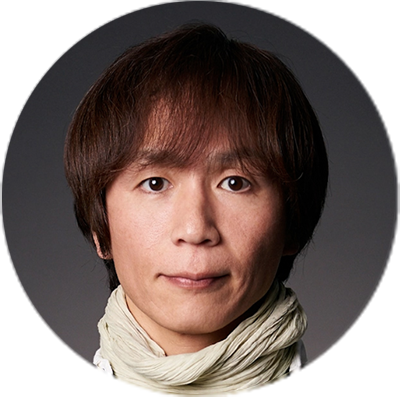
遠く離れた惑星・火星。
SFの世界では頻繁に舞台となり、さまざまな空想世界が描かれ、その未知なる場所に
ワクワク・ドキドキさせられてきました。
その一方で、火星探査は50年以上も前から続けられており、その地道な研究のおかげで
火星の実像がかなり詳細にわかってきています。
『JOURNEY TO LIFE』で旅する火星は、NASAが公開している地形データに基づき、リアルに再現しています。
ダイナミックな映像表現のため、まるで架空のSF映画のように思われるかもしれませんが、
実際に火星に行くとこういう感じなのかと思いながら体感いただくと、さらなる驚きにつながると思います。
人類が火星の地を踏むのはもう少し先になると思いますが、一足お先に、ぜひ、リアルな火星を体感してください。
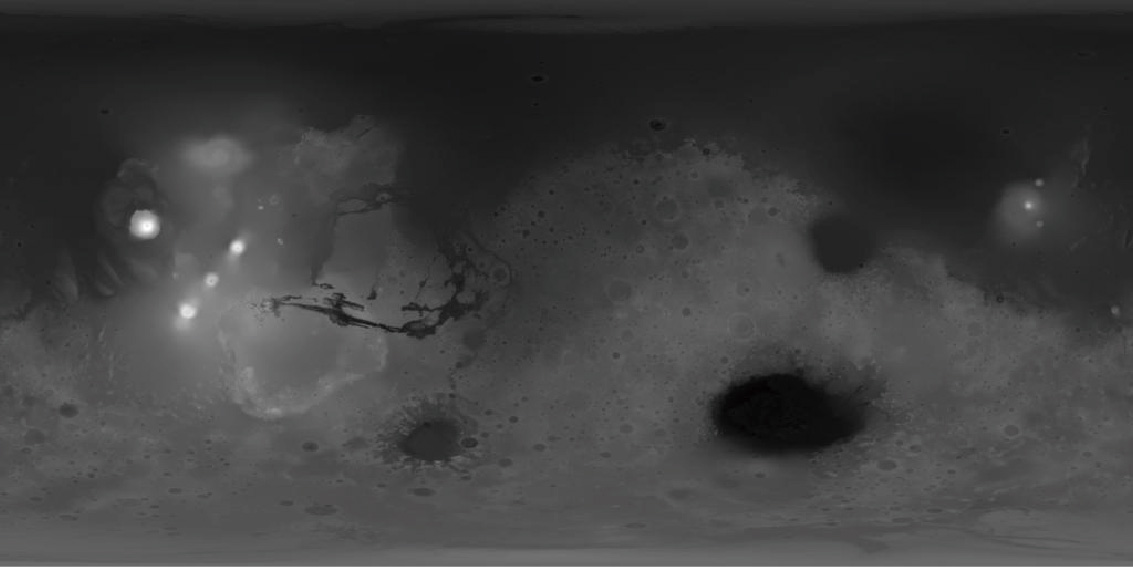
Image courtesy of USGS Astrogeology Science Center, NASA, DLR, and ESA
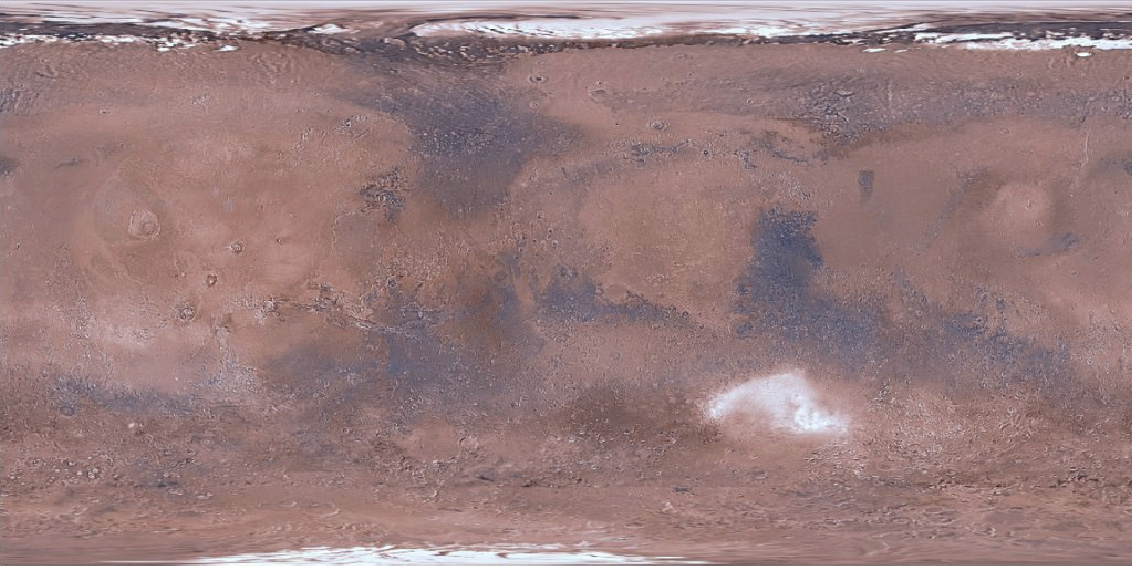
Image courtesy of NASA AMES and USGS Astrogeology Science Center

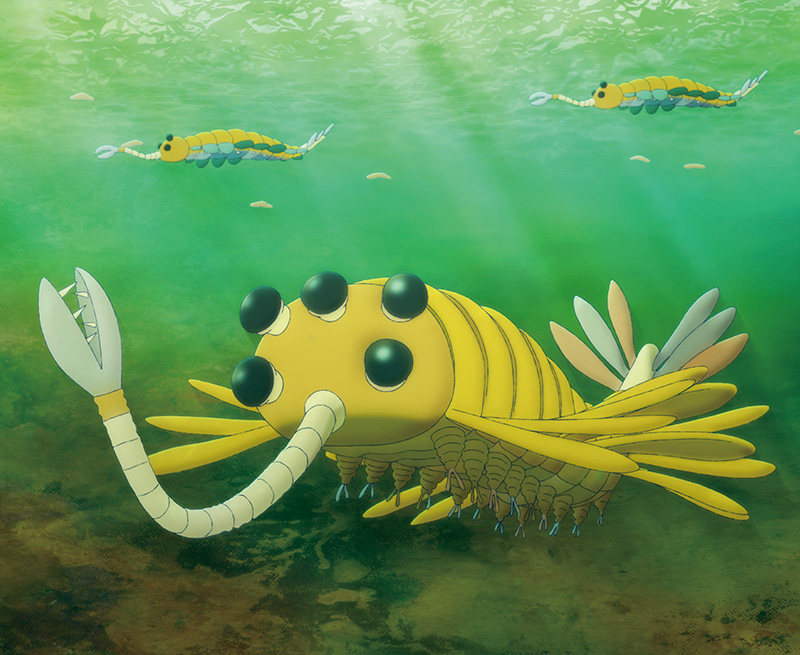
『JOURNEY TO LIFE』に登場するハルキゲニアやオパビニアなどの「姿」は、
化石で分かっている情報を元に再現。
しかし、化石では分からない「色」については、
あたかも多種多様なカンブリア紀の生き物たちを表現しているかのような
カラフルな色合いで、イマジネーション豊かに表現しています。
進化の過程でさまざまな形態を試み続けた太古の生きものたちに
畏敬の念を抱かずにはいられませんね。


作品中の「生命の広がり」のパートは、日本が世界に誇る手描きアニメーションで表現しています。
登場する不思議な生きものたちは、空想のものではなく、すべてが太古の時代に実際に生きていたものです。
その生命の躍動と祝祭感をより印象強く表現するため、写実的ではなくアート寄りの色表現にこだわり、
奇妙で、神秘的な古代の生きものたちを、まるで「ひとつのアート作品」として表現しました。
また、画面に青と赤のように反対色を入れるとインパクトのある印象的な絵になるため、
あえて反対色を取り入れることにより、ハッとするような力強い生命の姿が画面いっぱいに広がっています。
精鋭クリエイティブ集団「STUDIO4℃」が手描きアニメーションで描き出す圧倒的な生命の世界を、
ぜひ、大画面で体感してください。



火山活動と生命誕生には、密接な関係があったと考えられています。
地上では火山活動が見られる場所は数多く存在しますが、深海底ではその様子を見ることは極めて難しいことです。
枕状溶岩が形成されるシーンを再現した映像は、生命が誕生したと考えられている深海の環境がどのような場所であったのかを知る上でも、とても貴重なものとなっています。
深海底で感じる地球の息吹と神秘を、ぜひ、体感してください。
